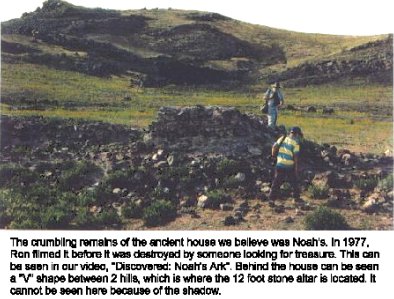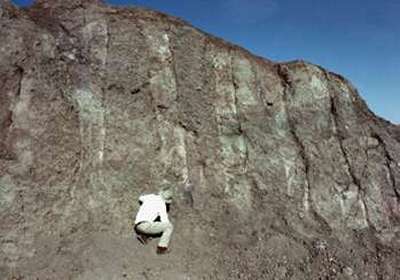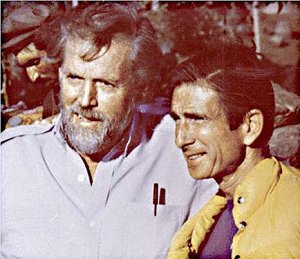The Search for Noah's Ark, part 2
The Fences -- Evidence of Noah's "Husbandry"
The ancient house -- was it Noah's? They only had one morning to
examine everything pertaining to the house, but the thick walls and the
vast pattern of stone fences was pretty compelling evidence. The Bible
gives reference to Noah being a "husbandman":
Genesis 9:20-23 "And NOAH BEGAN TO BE AN HUSBANDMAN, and he planted a
vineyard: And he drank of the wine, and was drunken; and he was
uncovered within his tent. And Ham, the father of Canaan, saw the
nakedness of his father, and told his two brethren without. And Shem and
Japheth took a garment, and laid it upon both their shoulders, and went
backward, and covered the nakedness of their father; and their faces
were backward, and they saw not their father's nakedness."
This passage tells that Noah was in a tent, not a house such as Ron had
found. But Ron learned that the inhabitants of this region, as in other
pastoral societies, still live in tents in the summer and in thick stoned
houses in the winter. This seems perfectly consistent with the mention of
a vineyard, which would have yielded its fruits in the warmer season
"Husbandry" is defined as "farming, as of livestock" (Random House
Dictionary). After the flood, it makes perfect sense that Noah bred the
animals and cared for them until the point in time that their numbers were
sufficient enough to eliminate the likelihood of their becoming extinct.
With only two of each unclean animal, if even one should not survive, that
animal would become extinct. And the extremely large pattern of stone
fences radiating out from the house, and extending on for a good distance
seemed consistent with this type of activity. The depth below the present
ground level of the house and fences shows their great antiquity. Over the
years, windblown dust and dirt raised the ground level, thus burying or
partially burying ancient surface structures.
What Noah Wore
In the above Scripture, we also included the entire passage which tells
about Noah becoming drunk and having his "nakedness" seen by Ham.
We
included this because of one tiny point: The pictographs on the
tombstones in front of the house show the men wearing a type of tunic.
This is entirely consistent with Noah's nakedness being seen when he
became
drunk- if he had had on pants or slacks like men wear today, he would have
remained covered, no matter how he may have been lying down in his drunkenness. But
with a tunic, like a dress, this would not be the case.
The Giant Altar and Its Complex
The house is located in an incredibly beautiful plain which runs
east/west. To the north and south are mountains. Unlike our country,
most of the terrain is rock in this region, especially in this isolated area,
except for the village where the anchor stones were located. But when Ron and the boys
looked behind the house to the north, they saw a very beautiful mountain
ridge -- directly behind the house.
This ridge had two small hills which met and formed a valley in between
them on the side of this ridge. In the middle of this
mountainside valley, Ron saw a VERY large square rock which looked as if
it had been deliberately set in that location. Behind this large rock the
valley formed a natural amphitheater. On the side of this very large rock
was a complex of small fenced-in areas.

If this was really Noah's house, this certainly looked like a very
large altar with room for a large number of people to sit behind it as the
sacrifices were made.
Genesis 8:20 "And Noah built an altar unto the LORD; and took of
every clean beast, and of every clean fowl, and offered burnt offerings
on the altar."
The altar itself measures 12' x 12' x 12' and it has one step. When we
stood upon it, it was obvious that whoever stood upon this altar was quite
a bit taller than we are, for the step is about three feet high. The
complex of pens adjacent to the altar also indicates that whoever arranged
the rocks in this pattern was very, very strong, because today many of the
large rocks could not possibly be moved by humans without mechanical
assistance. At one point, a very large boulder is balanced upon several
upright stones, forming a covered area that a six foot tall man can walk
under without stooping.
Also in this complex are two very large stones which display features
which indicate that they were used for the slaughter and bleeding of
animals. (Genesis. 9:4) One is consistent with the size of smaller animals
like sheep and goats; the other, much larger, is consistent with the size
of larger animals, such as bullocks. They both have a series of
chiseled-out indentions leading from the ground to the flattened, slightly
angled top. These indentions are the size that is consistent with animal
hooves. Perhaps the animals were led up the side of these rocks to the
top, which also contain chiseled out basins with drains, that are
consistent with areas for bleeding the animals prior to offering them on
the large altar stone. According to the biblical account, specific parts
of the animal were offered as sacrifice, then other parts were cooked and
eaten "before the Lord." (See Leviticus, chapters 1-9.)
DAY 3- the "Boat-Shaped Object"
Ron filmed and photographed everything. There is actually much more
than we have listed here, but these are the most important items. At the
end of day two in the ark region, they had seen more than enough to make the trip
worthwhile. The next day would be their last.
Arising the next morning, the boys were tired and stayed in the hotel room.
They had traversed across a great number of miles in the previous two days
and Ron knew they needed a break. So he got a taxi and returned to the
first pile of rocks. They had worked their way backwards from the third
pile to the first. And this one was quite a distance from the others.
This time, Ron had the taxi driver take him as far as he could go in the
direction that was perpendicular to this rock-pile. They traveled up into
the mountain range to the south, as far as there was a dirt road. When it
ended, Ron began to walk. With mountains everywhere, he wondered if he
would ever be able to spot the boat-shaped object if he looked right at
it- but soon he saw it. And what he saw convinced him more than ever that
this object was the remains of a ship. But, what he saw also convinced him
that there was only one way to explore its true nature, and that was by an
excavation to remove the soil which covered it.
He returned to the hotel room and they packed their things. He checked out that night so
they could leave early in the morning -- but that proved to be a big
mistake. In 1977, there weren't any tourists to speak of in this region.
It is desolate and very foreboding. The Kurdish villagers had been
watching Ron and the boys, waiting to make their move. As long as they
were staying in the hotel, they were spending money -- paying taxis and
guides. But these bandits wanted it all, and as soon as they realized Ron
was about to leave, they attacked.
It's a long story, but to summarize it, Ron and the boys heard robbers
coming up the steps banging pipes and making a lot of noise. Shoving the
furniture in front of the door, they tied the bed sheets together and
climbed out their third story window onto a roof below. There, they
climbed back into the second floor window which led into the kitchen, and
they ran through the hotel and out the door.
In the commotion, they lost almost all of their film. Ron did manage to
hang on to some of the movie film. Once they were safely out of town, they
realized how truly dangerous the region was. The boys would never go there
again -- and after all they went through, they would never see the "boat
shaped object" in person.
Back at Home -- Now What?
Ron had gone to Turkey for one reason -- his own personal curiosity.
What he saw, fueled his resolve to investigate the site more thoroughly,
but as a private individual, he had no idea where to start. He knew the
site needed to be excavated, but how could someone like himself get
permission to do so? And how could he interest important scholars and
archaeologists in the site when most people believed that if the ark
existed at all, it had to be on Mt. Ararat?
Dr. William Shea
In 1978, someone told Ron about another man who was interested in the
boat shaped object -- a man who is an MD and an archaeologist. This man is
Dr. Bill Shea of the Biblical Research Institute in Silver Spring, MD.
In November of 1978, Ron finally made contact with Dr. Shea, who had
written an article about the site in September 1976. He believed that the
site should be thoroughly investigated, and when comparing the boat-shaped
object to the current thought that the ark HAD to have landed on Mt.
Ararat, wrote:
"To conclude, one might put these two sites in perspective by
reflecting upon what would have happened had this formation been found
on Agri Dagh [Mt. Ararat]. I may be wrong, but I suspect that news of it
[the boat shaped formation] probably would have been heralded far and
wide as the discovery of the site where the Ark had rested. What a
difference a mountain makes." CREATION RESEARCH SOCIETY QUARTERLY,
Volume. 13, September. 1976, "The Ark-Shaped Formation in the Tendurek
Mountains of Eastern Turkey," by Dr. William H. Shea.
Dr. Shea also mentioned that he too believed that the Royal Egyptian
Cubit was used in giving the measurements of the ark:
"Assuming a Mosaic authorship for these measurements probably would
indicate that they were given in terms of the Egyptian cubit of 20.6
inches rather than the shorter Mesopotamian cubit."
After Ron and Dr. Shea discussed the information from
the August 1977 trip, Dr. Shea began to apply for permission to
excavate the ark. The reply from the Turkish Government was negative. As far as Ron was concerned, there was
nothing else he could do. So he waited, and for what, he didn't know.
Astounding News!
In 1978, Ron decided not to return to Turkey- instead, he and the boys
went to Egypt to research the Red Sea crossing site. Perhaps Dr. Shea
could one day get the permission they so desperately wanted. But then, in
late December, 1978, Ron heard a news report of an earthquake in eastern
Turkey.
He still remembers how his heart began to pound- HE couldn't excavate,
but perhaps "nature's" God had done what he couldn't!
1979 -- Return to Turkey
He had to patiently bide his time until his next two week vacation came
in August. On August 11, 1979, he arrived the second time in Istanbul
and headed for the ark site. This time, the boys didn't go. Ron wasn't going
to take any more chances with his young sons' safety, but he did take an
Armenian preacher from California who spoke Turkish.
When they arrived at the site, Ron just wasn't prepared for the
spectacular sight his eyes beheld -- the earthquake (which injured no one)
had dropped the earth around the object and there on the mountainside Ron
saw what looked like a giant shipwreck!

Evenly spaced indentations could be seen all the way around the object,
which looked like decaying rib timbers. The earthquake had also cracked
the object from "stem to stern" and Ron was able to take samples from deep
within. He also took samples of material outside of the object for
comparison.
He measured the object and got a 512 foot length -- but, he saw what
looked like a section about 1 yard long that was broken off from the lower
end. This was positive evidence in Ron's eyes: 300 Royal Egyptian cubits
were 515 feet- this object was 512 feet with a 3 foot section broken off
of the lower end- a total of 515 FEET!
He again inspected the anchor stones and the graveyard which had the
strange monuments which Ron believed had representations of the Ark and
its eight passengers. It was a short trip, but Ron had accomplished
more than he had hoped for. The next step was to have the samples
analyzed.
The First Laboratory Analyses
He had to get back home and return to work immediately, so it was
October before he managed to get the samples to Galbraith Labs in
Knoxville, Tennessee. This sort of testing is expensive, so
he only had each sample tested for a basic mineral analysis. That was
enough for a start. The sample outside the formation showed a 1.88%
carbon content; but the one from inside the crack yielded a 4.95% carbon
content, an amount that was consistent with the presence of prior living
matter, such as decayed or petrified wood. It also showed a surprisingly
high iron content.
It was another example of positive evidence -- but again, Ron found himself at a
standstill.
What next? Applications to excavate were still made, but each time they
returned
negative replies. Ron was in for an even longer wait this time. But in the
meantime, Ron decided to make all his information available to others.
"Noah's Ark Found"
Looking back, the evidence might not have seemed as convincing to
others as Ron thought it surely would have been. After all, he had been
there twice, he had seen the wonderful evidences which spoke of eight
survivors of the ark from that very region. But when he wrote it all up in
a booklet called "Noah's Ark Found", not everyone accepted the evidence
as overwhelming.
Ron told the story of his two trips to Turkey, what he saw, filmed and
photographed, and he gave the lab analyses and told about the tombstones
he believed marked the sites of Noah and his wife's graves. He explained
about the Royal Egyptian Cubit, which, considering the length of the boat
shaped object, he felt was overwhelming evidence.
He gave these to anyone who was interested, hoping to gain interest and
support from others who might want to help. But the fact of the matter is, this wasn't enough
for some people. In fact, this little booklet would one day be
responsible for the theft and destruction of one of the most incredible
evidences -- but it was a lesson Ron would have to learn the hard way.
Meanwhile, he had no real idea what he could do to further his research.
White's Electronics
Since all his investigation would have to be non-destructive, Ron
decided to check into the possibility of getting a metal detector to check
for the presence of metal in the ark. He called White's
Electronics in Sweet Home, Oregon and shared with them his project. They
listened to his proposal and found it to be a worthy and legitimate
research project, and shipped him two of their top metal detectors,
which Ron hoped to be able to use on the site.

Ron Wyatt and Col. Jim Irwin
In 1983, he read an article about Colonel. James Irwin, the Apollo 15
astronaut who was actively involved in searching for the ark on
Mt. Ararat. Ron called him and shared with him the information he had on
the boat shaped object. Colonel Irwin was extremely gracious, and said he
was interested. So, Ron drove out to Colorado and met with Jim at his
office. Jim was interested in seeing the site, and offered Ron any help he
could give him.
Jim was taking an expedition to climb Mt. Ararat in August of 1984, so
he and Ron decided to travel together so that Ron could show him the site. They arrived in Istanbul on August 19, 1984 and proceeded to Ankara.
Next Page:
First Metal Detector Scans
Index of Newsletters
Home
This page courtesy Anchor Stone International
www.anchorstone.com
|

![]()